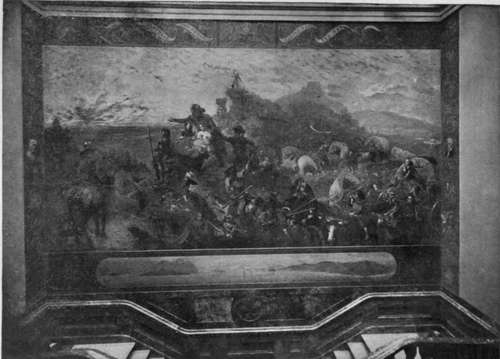Westward The Course Of Empire Takes Its Way
Description
This section is from the book "The National Capitol. Its Architecture Art And History", by George C. Hazelton, Jr. Also available from Amazon: The National Capitol Its Architecture Art and History.
Westward The Course Of Empire Takes Its Way
From the west corridor, a grand marble staircase ascends to the galleries of the House. At its foot is a bronze bust by Vincenti of the Chippewa Chief, Beeshekee, the 'Buffalo. On the walls above the landing is the popular picture known as "Westward the Course of Empire takes its Way." It is the work of the genial German-born artist, Emanuel Leutze, an historical painter of some distinction, and its title is a quotation from Bishop Berkeley. The scene is a panorama, impossible in extent, of western country. In the foreground are depicted the struggles and privations of an early wagon-train crossing a pass in the Rocky Mountains. Beyond are spouting geysers, grand canons and the El Dorado, stretching like a mirage of hope before the eyes of the weary travelers. The view is truly an inspiring one.
In the fanciful border to the right, the artist has placed a portrait of Daniel Boone and, beneath it, the appropriate quotation from Jonathan M. Sewall's Epilogue to Cato :
" The spirit moves with its allotted spaces, The mind is narrowed in a narrow sphere".
The corresponding portrait, worked into the border upon the left, is that of Captain William Clarke,whose pioneer story is so fascinatingly told by Wash-- ington Irving. Its quotation also is from Sewall:
" No pent-up Utica contracts our powers, But the whole boundless continent is ours. "
In the long narrow border beneath is seen the Golden Gate, the entrance to the harbor of San Francisco.
We owe the picture in great part to General Meigs, who took the responsibility of contracting for it with the artist and who, for his pains, received at the time much criticism on the score of extravagance. A sharp controversy regarding his accounts also arose with the Auditor of the Treasury. It seems that there was some discrepancy in dates owing to the fact that, in disregard of the letter of the law, money had been advanced to the artist to enable him to visit the frontier for the purpose of studying its scenes and making his sketches from life. The great popularity of the picture, however, compensates for the unkind reflections upon General Meigs, as it does also for its technical imperfections and totally impossible ensemble.
The work is what is known as stereochromy, a process of wall painting brought to perfection by Kaulbach and others. The immediate basis is a thin layer of cement composed of powdered marble, dolomite, quartz and air-worn quicklime. Upon this the colors, mixed with water, are applied. They adhere but loosely; and the artist, unlike in fresco, may work at leisure, and correct mistakes or hide blemishes at will. The colors are then fixed by applying a spray of water-glass solution, which, after a few days, gives to the surface hardness, transparency and a peculiar brilliancy of effect. The painting finally is washed with alcohol to remove the eliminated alkali and dust. This style of decoration is practically proof against atmospheric influences. Leutze is said to have studied the mechanism of the method under Kaul-bach.

WESTWARD THE COURSE OF EMPIRE TAKES ITS WAY.
The dullness in color is due to the partial failure of the artist properly to execute the method selected. The colors have so sunk into the wall as to lose the desired luster and leave a lifeless effect which materially detracts from the picture. Then, too, some of its best points are lost because the painting cannot be viewed from the proper distance. The contract for this work was executed in July, 1861. The artist worked rapidly and earnestly without regard to the great war that was then raging about the capital. The picture was completed in the autumn of 1862. The artist received #20,000.
Continue to:
